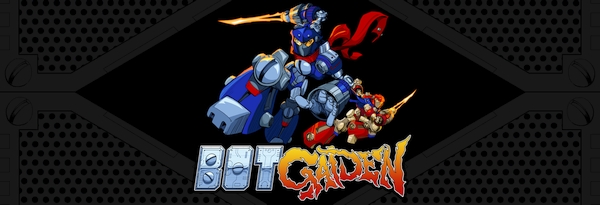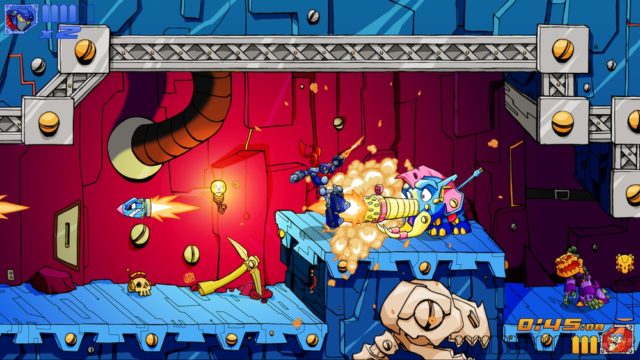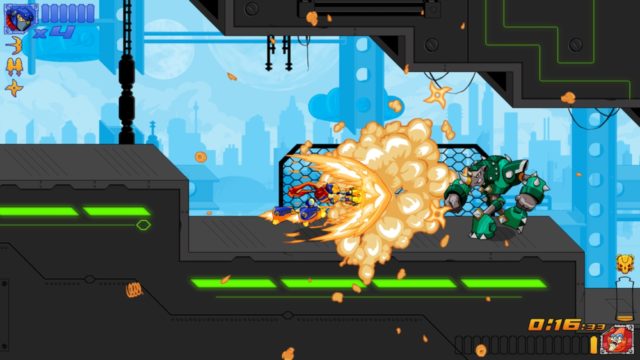
MetroidVanias rose to fame in the 80s and 90s thanks to the popularity of the Metroid and Castlevania franchises, but the genre went dormant in the 2000s as developers pushed pixels aside for polygons and aspired to create sprawling 3D worlds. After being rediscovered and remixed by the indie community, the MetroidVania is finally having its moment here in 2018.
But what if you’re looking for something else from a side-scroller? What if you want the fast action and self-contained levels that characterized the Ninja Gaiden and Contra franchises? Enter SwordSwipe Studios, and their upcoming game, Bot Gaiden.
The gameplay style and artistic inspirations for Bot Gaiden came to us straight from the 80s, but unlike most side-scrollers now on the market, SwordSwipe’s platformer doesn’t look like it came from the 80s. We sat down with Doug Pohl, one of the developer’s co-founders, to find out exactly how he’s bringing back the fast action and precision platforming of those classics in a new package.
John Scalzo, Warp Zoned Editor-In-Chief: How did SwordSwipe Studios get its start?
Doug Pohl, SwordSwipe Studios: Mike Gracik and I co-founded SwordSwipe Studios while working together as user experience designers. We had both previously been programmers, both gamers, and Mike had gone to school for game development. I was in several bands back then and never really entertained game development. But when one of Mike’s side game dev projects collapsed, we decided to pick up the pieces and work on it a little bit on lunch breaks, since we both had very limited time. That quickly blossomed and I gave up the band time to focus on gamemaking, where I could do all the things I love… art, music, creative writing, and design.
We incorporated SwordSwipe and set about working on a couple of mobile games. We knew there would be some growing pains, so we tried to keep the scope small and just finish something. We released Warp Wiz and Search for the Golden Gorilla on iOS and Android. It was a great experience, but we were ready to make a real gamer’s game after that. So we started on “Super Dragon Ninja,” which was a straight-up Ninja Gaiden clone. At that time, nobody was making that sort of game. We also thought it was a good idea to grow our team, so we added an artist and programmer. The chemistry there didn’t work, and we parted ways with them a few months later, which left us at a crossroads.
We still wanted to make this game, but with just two of us we had to trim scope hard. So we opted for a “stylized” art direction where I used simple geometric shapes. Bot Gaiden was born out of this constraint, because it was a lot easier to represent robots this way. That’s when it became so much more than a Ninja Gaiden clone. It really came to life by mixing in other influences like Mega Man, Contra, and a touch of our own magic.
The game was coming along really nicely, but every time we showed it off or tried to get attention, the art style was holding it back. People just weren’t all that interested. We did several full-on design overhaul iterations, but it just wasn’t getting anywhere and we were questioning whether or not to continue. That’s when we found Chad Feldpausch, our lead artist. He’s married to a former classmate of mine, and I happened to see a Facebook post of some of his work. I was blown away. With nothing to lose, I reached out after 20 some years to my classmate and soon Chad was on board. That’s how the three core members got together.
WZ – John: What kind of challenges do you face as a team comprised of “three gamer dads” that the public might not realize?
Pohl: Time is probably our biggest obstacle. We all have young families and day jobs. We’ve become masters of efficiency, eking out chunks of time wherever we can. My Surface Pro is the best thing ever. It goes with me everywhere, and I typically do some work before I start my day, at lunch, and in chunks at night and on weekends. We’d love nothing more than to make games full-time. We hope Bot Gaiden can help us down that path. But in the meantime, we have to support our families. This is a labor of love and a dream. And quite frankly, it’s a sacrifice… we’ve put in a ton of time and money toward this. We’re not some greedy, lazy, faceless developer. We’re real people just trying to make it work.
Another hurdle is with only three core members, we have to wear many hats. When I say I do “art and music”, there’s so much more… complete fields of expertise that other people would make an entire career out of [like] background artist, colorist, animator, video producer, sound engineer, UI designer, composer, effects artist, on and on. I’d love to sink my teeth into any one of these, but there’s only so much time in the day and we just have to do the best we can.
Lastly, as a small “hobbyist” (at least at this point) developer, we have trouble getting noticed. We fully recognize that marketing is the single biggest factor in our success, and all of us suck at it. We’re trying to get better, but once again that’s an entire career specialization. We could use help. And even though we are programmers and UX designers by trade, since we’re coming from outside the world of video games, we struggle a bit with industry cred.
WZ – John: How do you introduce Bot Gaiden to those who’ve never played it before?
Pohl: For those who came from our era, I like to say Bot Gaiden plays like Ninja Gaiden in Mega Man’s world with a dash of Contra. It’s a pure action game in every sense of the word. I enjoy MetroidVanias, but everybody is making a MetroidVania. Not many people are making what I’ve coined a “MegaContinja”: Straight up action platforming where you can see the entire level on screen, don’t grind on enemies, don’t explore, just decimate everything in your path. It’s all about execution and efficiency, not worrying about whether you’ve found every nook and cranny. There’s a place for those, but we wanted to do something different. And then we amped it up a bit with some new gameplay hooks of our own.
WZ – John: Bot Gaiden’s “Time Is Energy” mechanic looks very interesting. What can you tell me about that?
Pohl: Bot Gaiden is all about speed and efficiency, so time is a big factor. The setup here is that the eight Henchbots have taken control of the Golden Skulls, signaling great danger to the bot-world. As you attempt each level, the Henchbots are draining power from the skulls. So on-screen you see a Health Meter for the skull that is trickling into the empty-at-first boss’s Health Meter. This means that the quicker you can get to the boss, the easier they will be. It does cap out at what we would call a “standard” Health Meter, so there’s [really] no downside, just incentive to get there faster.
Additionally, any leftover skull power can be used to acquire upgrades. Everything from extra lives and health to upgrading your basic powerups [with a] spreadshot, triple jump, infinite dash attack, [or] making speed bursts last longer. These, of course, help you to go faster. So that’s our meta loop. Finish the stage faster, earn upgrades, finish the stage even faster, and so on. To the point where you’re trying to trim down each stage to its absolute most efficient run, thereby earning the most rewards, and better preparing you for the challenges to follow.
WZ – John: Bot Gaiden’s name and look lean heavily into elements inspired by Ninja Gaiden and Transformers, what other inspirations have helped shape the game?
Pohl: Aside from the 3 already mentioned: Ninja Gaiden, Mega Man, and Contra, I personally cite Super Punch-Out!! as the fourth major influence. It sounds strange because it doesn’t play like it at all, but there’s this mechanic where you’re building up a Super Punch Meter, and when you fill it, you have Super Punch ability for as long as you can stay perfect. But take damage, and you’re back to square one. I love this mechanic and we usually try to bake it into each of our games in some way to encourage this tension of being able to stay perfect. In Bot Gaiden, it’s our Augmentum System. So in each stage, you can acquire Augmentum Gears (Shuriken, Dash Attack, and Double Jump) that help you go faster. You get them one at a time, but they stack so you can use them all simultaneously. If you get hit, you lose them all. However, if you’re able to keep them, all subsequent Gears turn into speed boosts. So it really plays into our theme of playing fast, which can of course also get you into trouble. It’s a terrific tension.
With our cutscenes, we wanted to evoke the old-school cinematic feel of Ninja Gaiden, but we wanted to go a lot more light-hearted with our story, more like a Mega Man plot that serves as a prop for the action itself. In this way, we’ve also borrowed from Super Punch-out!! in that each cutscene plays out with some humorous, sarcastic banter between the bots and the boss Henchbot.
And then we always try to put as much of ourselves into the project as we can, so there are tons of what I’d call easter eggs or nods more than direct influences. You’ll find all of the above and more if you’re looking hard enough: Double Dragon, Strider, Transformers, Batman, Guns N Roses, GI Joe, Jayce and the Wheeled Warriors, Masters of the Universe, Super Mario Bros., Predator, RoboCop, Gremlins, DuckTales, Star Wars, and probably more by the time we’re done.
WZ – John: Bot Gaiden’s comic-style visuals seem to be sidestepping the “retro-inspired” graphics you see in a lot of side-scrollers nowadays. What made you decide to go in that direction?
Pohl: Two reasons, really. Personal taste and intentionally not following the crowd. Pixel art is cool, and I’ve enjoyed lots of those games, but I’ll take the hi-def hand-drawn version of Wonder Boy (for example) any day over the pixel equivalent. I think a lot of folks are doing the pixel art for the nostalgia, but they’re really missing the point of what made those games great underneath. (Some teams are doing both, which is great!) We’ve made a conscious effort in our company to make games that make you feel like you did when you were playing those originals, but with modern polish. Streamlined, tight gameplay. Imagination and wonder. Vibrant colors. Kick-ass music and sound.
Speaking of music, we’re taking a similar approach. When I think back to the early NES days, there was so much emotion tied to the music in those games. In the absence of voice acting, games really relied on music to convey the mood, and some really awesome pieces were born out of this constraint. Music these days is often relegated to background ambiance, and in our games we want music to take center stage. I’ve composed the music at its core to be limited in the amount of layers, to really nail the emotion like the old NES games. But we’re not doing chiptunes. For Bot Gaiden, we’ve partnered with renowned video game cover artist and master of kick-ass metal Daniel Tidwell, who is performing and producing our soundtrack. I really think it’s going to stand out and be something special.
WZ – John: Bot Gaiden is currently in development for the PC, but when can we expect to play it? And are you also targeting the PS4, Xbox One, or Switch?
Pohl: Being so small and so limited in time, it’s a little harder for us to be exact, but we’ve been targeting Steam Early Access in early 2019 where we’d introduce a few stages at a discounted price for early adopters. This would be mostly to help get some exposure and start to refine the difficulty tuning. We seem to be on pace for that, with a full release happening sometime later next year, targeting Summer. You can wishlist us right now on Steam, so you’ll get notifications when all this takes place.
We want to be on all consoles, and we’re using GameMaker Studio for our engine, so that should be in the cards. We think we’re an especially good fit for Nintendo, and the Switch’s two-player local co-op on the go is a match made in heaven. There is absolutely no hesitation on our part, our main obstacle is getting approved by [the console manufacturers], which so far has been disappointing. We may be shopping for publishers soon to help us out on that front, and with marketing in general.
WZ – John: So is there anything else you’d like to say about Bot Gaiden?
Pohl: Only that if any of this sounds cool to you, please follow us on Twitter (@BotGaiden) and retweet/share as much as possible. Our single biggest hurdle is getting noticed, and we can use all the help we can get! Thanks!








